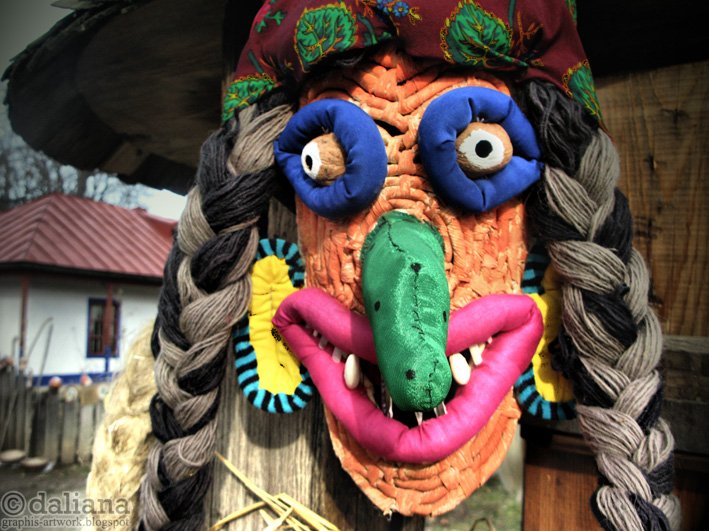
*photo: romanian ceremonial mask from folklore
In the old age, this night represented the unavoidable slipping into the cold season, and because the winter solstice was overlapping with the Roman celebration, Saturnalia (under which influence the romanian culture of our current age still is), Noaptea Sfântului Andrei, or Saint Andrew's Night, was a celebration of the most common motif in the romanian culture: it was a celebration of death and rebirth. In the ancient Dacian culture, the New Year was celebrated from the 29th of November until the 14th of December, thus making Saint Andrew's Night a celebration of Death(of the old year and of the nature).
Coincidently just like the pagan's Samhain, Saint Andrew's Night still is the night when conjurers, shamans, and village elders still gather and build huge fires in order to repeal the spirits that seek, in their belief, to "feed" on the living, a post-Christian belief originated out of the corruption of the original beleifs that included marking of the starting of the kingdom(season) of death(of nature) and the ending of the harvest season(which is not celebrated alongside with Samhain). In some parts of Romania and Transylvania, people are performing ritualistic dances with swirling balls of fire, and although this remained within the lore as a traditional thing to do, it's purpose was in the origins very similar to what I said before.
In this night, customs such as "Basil under the pillow"(the belief that young girls will dream their future husband if they sleep with a basil under their pillows) and "garlic hanging"(the belief that hanging garlic over the front door will keep the evil spirits away - most probably inspired from an offering type of custom from the animistic and shamanistic periods of ancient Romanian folklore) are still practiced now days.
Also, this night is famously useful for the witches within the romanian, Transylvanian, and gypsy culture, since they believe that hexes and curses are best to be performed in this day, and surprisingly they also believe that uncrossing(curse brraking) rituals are to be very potent as well.
Saint Andrew's Night remains an important holiday in the Romanian folklore, but it's meaning and importance was highly influenced by Christianity, thus no longer representing a treshold between the worlds and the seasons, but it became more of another opportunity for the curch to appeal at the peasants' fears of the unknown and call it's people into prayer as this quote from a poem written in the winter of 1857 in Iași(city from North-Eastern Romania) shows us:
"Voi, cu suflete curate,
Cu credinți nestrămutate,
Oameni buni, femei, copii!
Voi, creștinelor popoare,
Faceți cruci mântuitoare,
Căci e noaptea-ngrozitoare,
Noaptea Sfântului Andrii!"
Which means:
"You, those clean in souls,
With unshaken faith,
Good men, women, children!
You, Christian Nations,
Make the sign of the holy cross,
Because this night is to be dreadful,
Saint Andrew's Night!"
In the old age, this night represented the unavoidable slipping into the cold season, and because the winter solstice was overlapping with the Roman celebration, Saturnalia (under which influence the romanian culture of our current age still is), Noaptea Sfântului Andrei, or Saint Andrew's Night, was a celebration of the most common motif in the romanian culture: it was a celebration of death and rebirth. In the ancient Dacian culture, the New Year was celebrated from the 29th of November until the 14th of December, thus making Saint Andrew's Night a celebration of Death(of the old year and of the nature).
Coincidently just like the pagan's Samhain, Saint Andrew's Night still is the night when conjurers, shamans, and village elders still gather and build huge fires in order to repeal the spirits that seek, in their belief, to "feed" on the living, a post-Christian belief originated out of the corruption of the original beleifs that included marking of the starting of the kingdom(season) of death(of nature) and the ending of the harvest season(which is not celebrated alongside with Samhain). In some parts of Romania and Transylvania, people are performing ritualistic dances with swirling balls of fire, and although this remained within the lore as a traditional thing to do, it's purpose was in the origins very similar to what I said before.
In this night, customs such as "Basil under the pillow"(the belief that young girls will dream their future husband if they sleep with a basil under their pillows) and "garlic hanging"(the belief that hanging garlic over the front door will keep the evil spirits away - most probably inspired from an offering type of custom from the animistic and shamanistic periods of ancient Romanian folklore) are still practiced now days.
Also, this night is famously useful for the witches within the romanian, Transylvanian, and gypsy culture, since they believe that hexes and curses are best to be performed in this day, and surprisingly they also believe that uncrossing(curse brraking) rituals are to be very potent as well.
Saint Andrew's Night remains an important holiday in the Romanian folklore, but it's meaning and importance was highly influenced by Christianity, thus no longer representing a treshold between the worlds and the seasons, but it became more of another opportunity for the curch to appeal at the peasants' fears of the unknown and call it's people into prayer as this quote from a poem written in the winter of 1857 in Iași(city from North-Eastern Romania) shows us:
"Voi, cu suflete curate,
Cu credinți nestrămutate,
Oameni buni, femei, copii!
Voi, creștinelor popoare,
Faceți cruci mântuitoare,
Căci e noaptea-ngrozitoare,
Noaptea Sfântului Andrii!"
Which means:
"You, those clean in souls,
With unshaken faith,
Good men, women, children!
You, Christian Nations,
Make the sign of the holy cross,
Because this night is to be dreadful,
Saint Andrew's Night!"
Hi! I am a robot. I just upvoted you! I found similar content that readers might be interested in:
http://www.imgoor.com/instagram-user/hex.mania/6627621999/